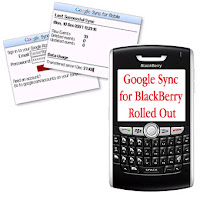 Google is releasing a beta version of Google Sync for the iPhone and Windows Mobile phones, providing the ability to synchronize Gmail contact information and Google Calendar events with handheld phones. The technology is based on the Microsoft Exchange ActiveSync protocol, licensed by Google.
Google is releasing a beta version of Google Sync for the iPhone and Windows Mobile phones, providing the ability to synchronize Gmail contact information and Google Calendar events with handheld phones. The technology is based on the Microsoft Exchange ActiveSync protocol, licensed by Google.Sync uses push technology to send changes to the device; the connection is always on so users don't have to manually synchronize their phones after Sync is set up. Changes to phones can be made in a user's Google account.
Additionally, Nokia and Sony Ericsson devices supporting the SyncML protocol allow for two-way contacts synchronization via Google Sync. Google Calendar sync and Contacts sync already has been available for the RIM BlackBerry smartphone, Google said.
But that software for RIM does not use Exchange ActiveSync.
Microsoft previously licensed ActiveSync to Apple, Nokia, Palm, Samsung, and Sony Ericsson. But the company is not seeking to make ActiveSync an industry standard, a Microsoft representative said.
Google, according to Microsoft, is taking a patent license to implement the Exchange ActiveSync protocol on Google servers that provide Google hosted services for purposes of synchronizing personal information management information with mobile handsets that implement Exchange ActiveSync protocol.
Google Sync is a good solution for small businesses relying on Gmail, said analyst Chris Hazelton, research director for mobile and wireless at The 451 Group.
